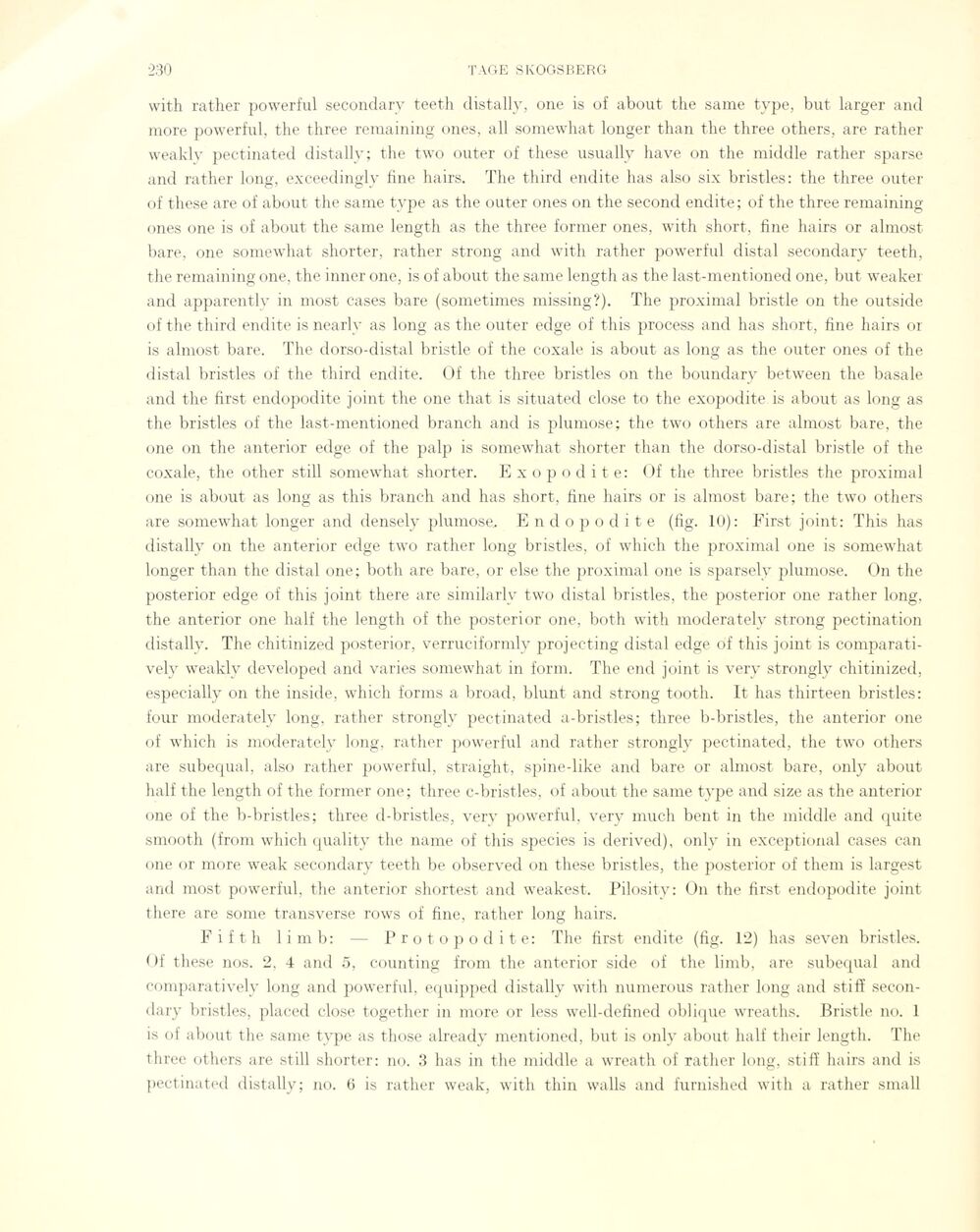
Full resolution (JPEG) - On this page / på denna sida - Sidor ...

<< prev. page << föreg. sida << >> nästa sida >> next page >>
Below is the raw OCR text
from the above scanned image.
Do you see an error? Proofread the page now!
Här nedan syns maskintolkade texten från faksimilbilden ovan.
Ser du något fel? Korrekturläs sidan nu!
This page has never been proofread. / Denna sida har aldrig korrekturlästs.
with rather powerful secondary teeth distally, one is of about the same type, but larger and
more powerful, the three remaining ones, all somewhat longer than the three others, are rather
weakly pectinated distally; the two outer of these usually have on the middle rather sparse
and rather long, exceedingly fine hairs. The third endite has also six bristles: the three outer
of these are of about the same type as the outer ones on the second endite; of the three remaining
ones one is of about the same length as the three former ones, with short, fine hairs or almost
bare, one somewhat shorter, rather strong and with rather powerful distal secondary teeth,
the remaining one, the inner one, is of about the same length as the last-mentioned one, but weaker
and apparentlv in most cases bare (sometimes missing?). The proximal bristle on the outside
of the third endite is nearly as long as the outer edge of this process and has short, fine hairs or
is almost bare. The dorso-distal bristle of the coxale is about as long as the outer ones of the
distal bristles of the third endite. Of the three bristles on the boundary between the basale
and the first endopodite joint the one that is situated close to the exopodite is about as long as
the bristles of the last-mentioned brauch and is plumose; the two others are almost bare, the
one on the anterior edge of the palp is somewhat shorter than the dorso-distal bristle of the
coxale, the other still somewhat shorter. Exopodite: Of the three bristles the proximal
one is about as long as this brauch and has short, fine hairs or is almost bare; the two others
are somewhat longer and densely plumose. Endopodite (fig. 10): First joint: This has
distally on the anterior edge two rather long bristles, of which the proximal one is somewhat
longer than the distal one; both are bare, or else the proximal one is sparsely plumose. On the
posterior edge of this joint there are similarlv two distal bristles, the posterior one rather long,
the anterior one half the length of the posterior one, both with moderately strong pectination
distally. The chitinized posterior, verruciformly projecting distal edge of this joint is
comparati-vely weakly developed and varies somewhat in form. The end joint is very strongly chitinized,
especially on the inside, which forms a broad, blunt and strong tooth. It has thirteen bristles:
four moderately long, rather strongly pectinated a-bristles; three b-bristles, the anterior one
of which is moderately long, rather powerful and rather strongly pectinated, the two others
are subequal, also rather powerful, straight, spine-like and bare or almost bare, only about
half the length of the former one; three c-bristles, of about the same type and size as the anterior
one of the b-bristles; three d-bristles, very powerful, very much bent in the middle and quite
smooth (from which qua li ty the name of this species is derived), only in exceptional cases can
one or more weak secondary teeth be observed on these bristles, the posterior of them is largest
and most powerful, the anterior shortest and weakest. Pilosity: On the first endopodite joint
there are some transverse rows of fine, rather long hairs.
Fifth limb: — Protopodite: The first endite (fig. 12) has seven bristles.
Of these nos. 2, 4 and 5, counting from the anterior side of the limb, are subequal and
compara tively long and powerful, equipped distally with numerous rather long and sti ff
secondary bristles, placed close together in more or less well-defined oblique wreaths. Bristle no. 1
is of about the same type as those already mentioned, but is only about half their length. The
three others are still shorter: no. 3 has in the middle a wreath of rather long, stiff hairs and is
pectinated distally; no. 6 is rather weak, with thin walls and furnished with a rather small
<< prev. page << föreg. sida << >> nästa sida >> next page >>